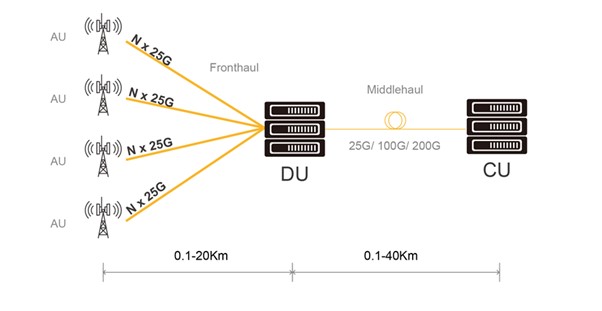-
With the launch of 25Gbps VCSELs, Seoul Viosys is targeting the $1.1B VCSEL market including 5G and data communication application market
-
Seoul Viosys is fully equipped for mass production of VCSELs, with initial approval to supply three major customers
-
Mass production of VCSELs for sensor applications is scheduled to start in the first quarter of 2021
ANSAN, South Korea (January 28, 2021) – Seoul Viosys (KOSDAQ: 092190), a leading compound semiconductor provider, announced that for the first time in Korea, Seoul Viosys succeeded in developing vertical cavity surface emitting laser (VCSEL) technology, a near-field-only 25Gbps laser diode compatible with 5G wired networks for transmitting and receiving, and has started mass production to supply these products to three initial customers.

[Figure 1] Schematic diagram of 5G network application using Seoul Viosys’ VCSELs
VCSEL is a laser diode technology that converts electrical signals into optical signals. It has recently attracted attention as a light-based communication technology that achieves ultra-high-speed data communication in 5G environments. This technology is necessary for AR/VR, 3D sensing and the camera-applied ToF (Time of Flight) for smartphones, and automotive LiDAR. Seoul Viosys’ VCSELs for sensor applications have already received customers’ approval and will be mass-produced within the first quarter of 2021, and the LiDAR technology is also undergoing the approval process to be supplied to an automotive system solution provider.
The 25Gbps VCSEL developed by Seoul Viosys is a high-performance laser diode technology that emits light vertically from semiconductor substrates to enable fast communication. Currently, the 25Gbps VCSEL market has seen three large U.S. companies – II-VI, Lumentum, and Broadcom – involved in a power struggle for these high value-added products, which have more than 10 times of selling price that of LED. Seoul Viosys can be implemented in a single channel or four-channel configurations, depending on its intended use, and the four-channel implementation features 100Gbps (4x) of high-capacity and high-quality data reception and transmission. Although the VCSEL technology exhibits a high degree of difficulty in implementation, it is expected to cover a wide range of applications in the future, as it is price competitive compared to horizontal-type laser diodes that emit light from the sides.

[Figure 2] Seoul Viosys’ 25Gbps VCSEL (left) and 100Gbps 4-channel VCSEL (right)
“As the paradigm shift has progressed in the recent noncontact era, interest in VCSEL technology is growing, since it is a critical technology for implementing the Internet of Things (IoT) environment. Seoul Viosys will continue to research and develop the VCSEL technology to expand and apply our differentiated VCSELs to 5G communication-based smart cities, autonomous driving applications, AR/VR, and industrial IoT markets,” said an official at Seoul Viosys.
Source: Seoul Viosys













